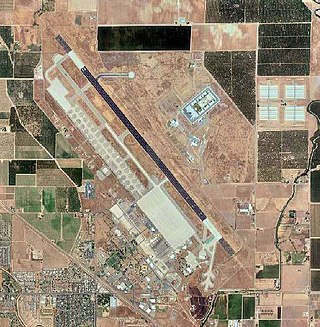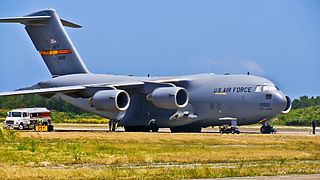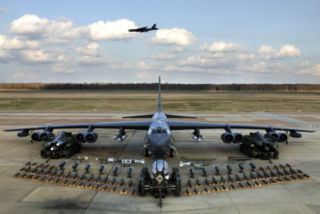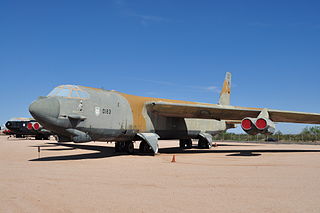
Strategic Air Command (SAC) was a United States Department of Defense Specified Command and a United States Air Force (USAF) Major Command responsible for command and control of the strategic bomber and intercontinental ballistic missile components of the United States military's strategic nuclear forces from 1946 to 1992. SAC was also responsible for strategic reconnaissance aircraft; airborne command posts; and most of the USAF's aerial refueling aircraft.
During Operation Arc Light from 1965 to 1973, the United States Air Force deployed B-52 Stratofortresses from bases in the U.S. Territory of Guam to provide battlefield air interdiction during the Vietnam War. This included strikes at enemy bases, supply routes, and behind the lines troop concentrations, as well as occasionally providing close air support directly to ground combat operations in Vietnam.

Barksdale Air Force Base is a United States Air Force (USAF) base in Bossier Parish, Louisiana, in northwest Louisiana. Much of the base is within the city limits of Bossier City, Louisiana, along the base's western and northwestern edge. Barksdale AFB occupies more than 22,000 acres (89 km2) east of Bossier City and along the southern edge of Interstate 20. More than 15,000 active-duty and Air Force Reserve Command (AFRC) members serve at Barksdale.

The AGM-86 ALCM is an American subsonic air-launched cruise missile (ALCM) built by Boeing and operated by the United States Air Force. This missile was developed to increase the effectiveness and survivability of the Boeing B-52G and B-52H Stratofortress strategic bombers, allowing the aircraft to deliver its payload from a great distance. The missile dilutes an enemy's forces ability to respond and complicates air defense of its territory.

Castle Air Force Base is a former United States Air Force Strategic Air Command base in California, northeast of Atwater, northwest of Merced, and about 115 miles (185 km) south of Sacramento.
Carswell Air Force Base is a former United States Air Force (USAF) base, located northwest of Fort Worth, Texas. For most of its operational lifetime, the base's mission was to train and support heavy strategic bombing groups and wings.

The 380th Air Expeditionary Wing is a provisional unit of the United States Air Force Air Combat Command (ACC). It is attached to the United States Air Forces Central Command component of ACC and is stationed at Al Dhafra Air Base, United Arab Emirates.

The 5th Bomb Wing is a United States Air Force unit assigned to Air Force Global Strike Command's Eighth Air Force. It is stationed at Minot Air Force Base, North Dakota. The wing is also the host unit at Minot. The 5 BW is one of only two active duty Boeing B-52H Stratofortress wings in the United States Air Force, the other being the 2nd Bomb Wing at Barksdale Air Force Base, Louisiana. Also, stationed at Barksdale Air Force Base, and operating the B-52H is a third unit, the 307th Bomb Wing, which is part of the Air Force Reserve Command.

The 97th Air Mobility Wing is a United States Air Force (USAF) unit assigned to Nineteenth Air Force of Air Education and Training Command. It is stationed at Altus Air Force Base, Oklahoma. The wing is also the host unit at Altus. It plans and executes McDonnell Douglas C-17 Globemaster III, Boeing KC-46, and Boeing KC-135 Stratotanker pilot and aircrew training, providing formal school initial and advanced specialty training programs for up to 3,000 students annually. The training is done in a three-phase approach: Academic Phase, Simulator Phase, and Flying Phase.

The 2nd Bomb Wing is a United States Air Force unit assigned to the Air Force Global Strike Command and the Eighth Air Force. It is stationed at Barksdale Air Force Base, Louisiana. The wing is also the host unit at Barksdale. The wing was assigned to the Air Force Global Strike Command in February 2010 as part of the reassignment of Eighth Air Force.

The 93d Air Ground Operations Wing is a United States Air Force unit assigned to Air Combat Command, Ninth Air Force. It is stationed as a tenant unit at Moody Air Force Base, Georgia.

The 397th Bombardment Wing is an inactive United States Air Force unit, last assigned to the 45th Air Division of Strategic Air Command at Dow Air Force Base, Maine, where it was inactivated on 25 April 1968.

The Boeing B-52 Stratofortress is an American long-range, subsonic, jet-powered strategic bomber. The B-52 was designed and built by Boeing, which has continued to provide support and upgrades. It has been operated by the United States Air Force (USAF) since the 1950s, and by NASA for nearly 50 years. The bomber can carry up to 70,000 pounds (32,000 kg) of weapons and has a typical combat range of around 8,800 miles (14,200 km) without aerial refueling.

Operation Chrome Dome was a United States Air Force Cold War-era mission from 1961 to 1968 in which B-52 strategic bomber aircraft armed with thermonuclear weapons remained on continuous airborne alert, flying routes that put them in positions to attack targets in the Soviet Union if they were ordered to do so. The exact routes varied by year, but in general there were routes that went to positions over the Canadian arctic, Alaska, Greenland, and the Mediterranean Sea. Many American Air Force bases in the 1960s allocated at least one bomber crew to "Chrome Dome" duty on a regular basis, and many other bases, including foreign bases, were involved in the refueling operations. Over the years the mission involved overflights of American, Canadian, Danish (Greenland), and Spanish territory, among others. The goal of "Chrome Dome" was to keep a number of nuclear-armed aircraft in a position to help guarantee nuclear retaliation against the Soviet Union in the event that the latter was somehow able to destroy the majority of US nuclear weapons still on the ground, while also ensuring that Strategic Air Command bomber crews had experience with airborne alert procedures so that, in the event of heightened concern, the number of patrolling bombers could be increased dramatically. Several high-profile nuclear accidents were associated with the "Chrome Dome" program, including the accidental release of nuclear weapons on foreign territory, and it was shut down in the wake of one such accident in 1968.

The 71st Air Refueling Squadron is an inactive United States Air Force unit. It was last assigned to the 458th Operations Group at Barksdale Air Force Base, Louisiana where it was inactivated on 1 April 1994.

The 596th Bomb Squadron is an inactive United States Air Force unit. It was last assigned to the 2d Operations Group at Barksdale Air Force Base, Louisiana, where it was inactivated on 1 October 1993, and its resources transferred to another unit.

The 1990–1991 Gulf War was the last major United States Air Force combat operation of the 20th Century. The command and control of allied forces deployed to the Middle East initially as part of Operation Desert Shield, later engaging in combat operations during Operation Desert Storm, were assigned to United States Central Command Air Forces (USCENTAF), the USAF component of the Joint United States Central Command.
















